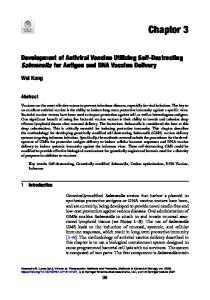Nanobiomaterials For Controlled Release Of Drugs & Vaccine Delivery
- PDF / 3,086,649 Bytes
- 6 Pages / 612 x 792 pts (letter) Page_size
- 55 Downloads / 355 Views
0920-S06-06
Nanobiomaterials For Controlled Release Of Drugs & Vaccine Delivery A. Vaseashta1, A. Erdem2, and I. Stamatin3 1 Department of Physics & Graduate Program in Physical Sciences, Marshall University, Nanomaterials Processing & Characterization Laboratories, Huntington, WV, 25755-2570 2 Analytical Chemistry Department, Ege University, 35100 Bornova, Izmir, Turkey 3 3 Nano & Alternative Energy Sources Research Center, University of Bucharest, Faculty of Physics, Bucharest- Magurele, Bucharest, Romania
ABSTRACT A number of natural and synthetic, and biodegradable polymers were investigated and remain to be elucidated for both soft and hard tissue repair, and for possible construction of excipient therapeutic templates. Nonwoven matrices from poly (ε-caprolactone) (PCL) homopolymers and poly (L-lactide/ε-caprolactone) (PLLA/CL) copolymers by electrospinning process were investigated for possible applications in burn/wound dressings. Efforts are currently underway to control the release characteristics of these biodegradable fibers by varying aliphatic polyesters. This perspective will have a profound effect on the time-controlled transport of vaccine to a targeted site. These materials will play a key role in developing novel chemotherapeutic agents that could be important in targeting specific genes and may provide selective control of gene expression. Furthermore, these fibers-by-design address many issues relating to the fundamental challenges in the synthesis of novel, biocompatible and safe delivery of vaccine and nanofiber materials to foster antibacterial and/or hygienic functionality, Systemon-Fibers (SoF), and will have tremendous application in global security and defense. INTRODUCTION Various nanoscale materials, devices, and systems with remarkable properties have recently been developed, exhibiting numerous unique applications in chemical and biological sensors, nanophotonics, nanobiotechnology, and in-vivo analysis of cellular processes at nanoscale. These developments in nanoscience and nanotechnology will revolutionize research on and applications in the areas of biology, medicine, human health, and provide unprecedented means to diagnose and cure diseases, and forewarn and/or provide protection against the potential risk for inadvertent or deliberate contamination of the environment, food and agricultural products [1]. Additionally, due to recent threats posed by the weapons of mass destruction (WMD), the future success of bio-defense in the world will demand the development of a novel and complex set of materials and devices. There are several methods of producing nanostructured materials ranging from nanopores to materials with varying degrees of dimensions [2]. The process of electrospinning provides a unique possibility to produce fibers of varying porosity and thus high surface area. The high surface area/volume ratio combined with its potential biocompatibility and biodegradable nature offers tremendous promise for diverse biomedical applications from tissue engineering, targeted vaccin
Data Loading...











